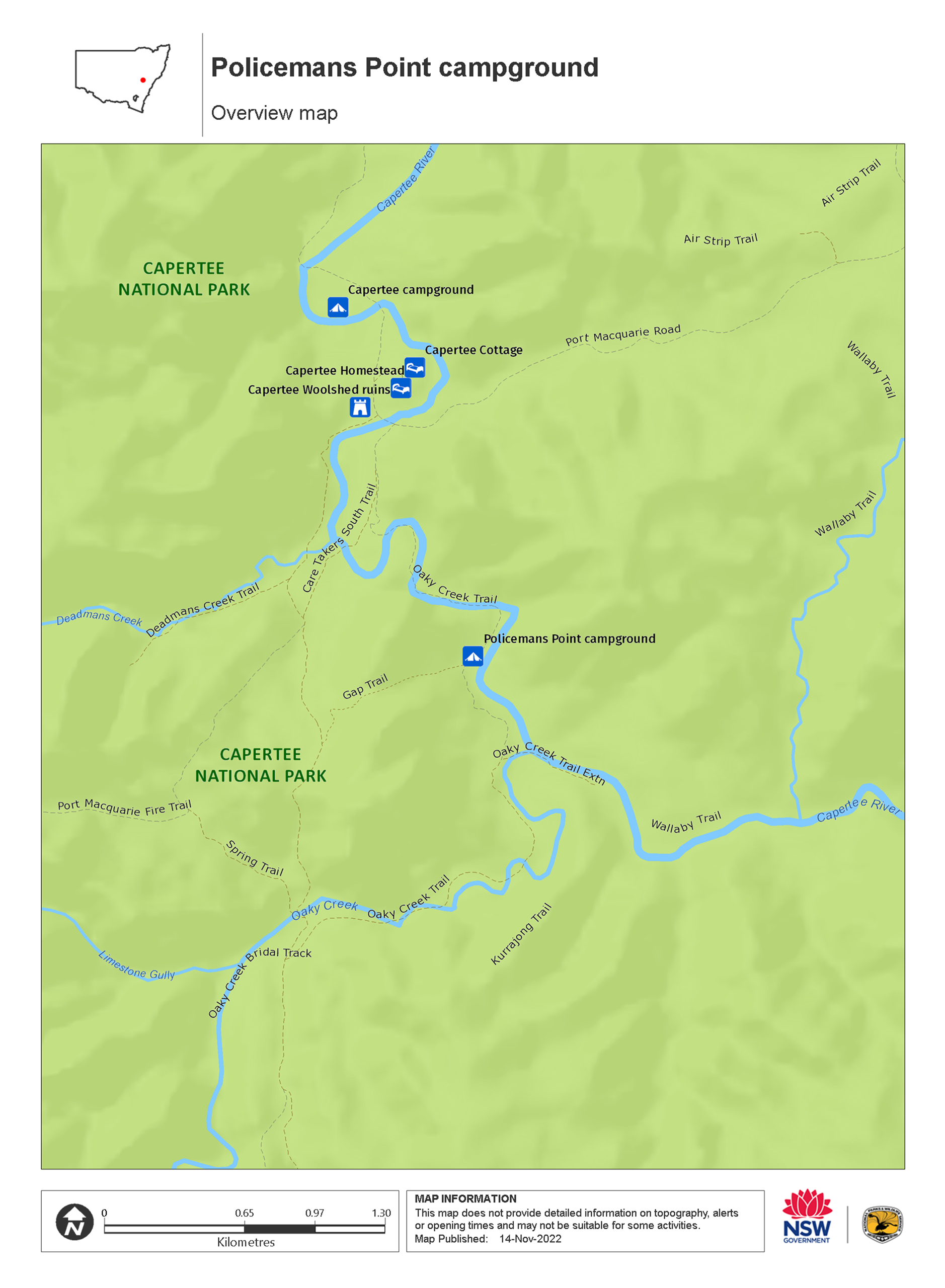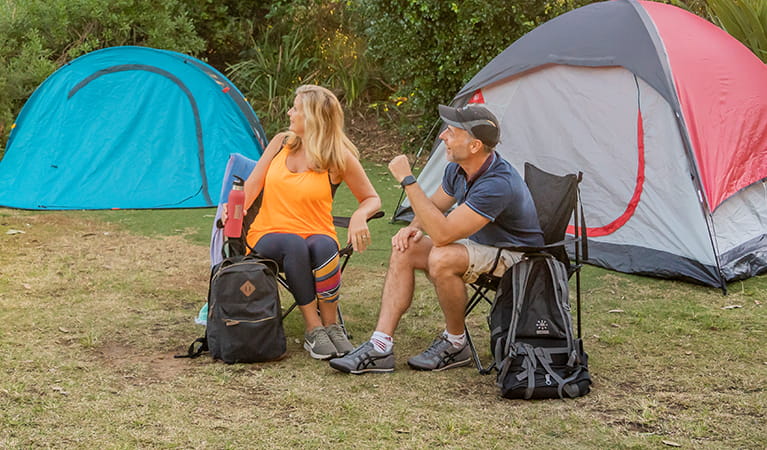Policemans Point campground
Capertee National Park
Overview
Policemans Point campground, in Capertee National Park, is a great place for setting up a bush campsite with nearby swimming, walking, cycling and birdwatching opportunities.
| Camping type | Tent, Remote/backpack camping |
|---|---|
| What to bring | Cooking water, drinking water, fuel stove |
| Price | There are no camping fees at this campground but a $6 booking fee applies. |
| Bookings | Book up to 12 people or 2 sites online. |
| Group bookings | School groups and Park Eco Pass holders can make a group booking enquiry. |
| Please note |
|
Most things in life are far more satisfying when you have to work for them, so make your way to Policemans Point campground – accessible only by hiking or mountain biking. Be rewarded for your efforts with a peaceful campsite on the banks of the beautiful Capertee River, where there are no vehicles or generators to be heard, just the sounds of the natural environment. Go for a swim if the weather’s warm and the river’s running. Explore the area further by heading off for a riverside walk.
Bring your binoculars for birdwatching and keep an eye out too for wallabies and wombats. At dusk and dawn, you’re likely to see more wildlife.
This campground is suitable for anyone willing to leave the car behind and ‘go bush’. It’s also an ideal place to try bush camping for the first time, as you can park as close as 1km away.
Map

Map legend

Local alerts
For the latest updates on fires, closures and other alerts in this area, see https://www.nationalparks.nsw.gov.au/camping-and-accommodation/campgrounds/policemans-point-campground/local-alerts
Bookings
- National Parks Contact Centre
- 7am to 7pm daily
- 1300 072 757 (13000 PARKS) for the cost of a local call within Australia excluding mobiles
- parks.info@environment.nsw.gov.au
Operated by
- Mudgee office
- Monday to Friday, 9am to 4:30pm.
- 02 6370 9000
- npws.mudgee@environment.nsw.gov.au
- 27 Inglis Street, Mudgee NSW 2850
Park info
- in Capertee National Park in the Sydney and surrounds and Country NSW regions
Capertee National Park has a locked entry gate. If you're visiting during the day, get the gate code by calling Mudgee Office (weekdays) or Blue Mountains Heritage Centre (weekends).
Visitor info
All the practical information you need to know about Policemans Point campground.
Getting there and parking
Policemans Point campground is in the southern precinct of Capertee National Park. To get there:
- Follow Port Macquarie Road to the locked gate at the park boundary (the access code can be obtained from Mudgee office). Once within the park, leave your vehicle on Carinya trail.
- Walk or cycle from Carinya trail along Policemans track for 1km, or walk or cycle from Carinya trail along Oaky Creek trail for 2.5km.
Road quality
- Unsealed roads
Vehicle access
- No vehicle access
Parking
Parking is available on Carinya trail, which are both walking or cycling distance from Policemans Point campground.
Best times to visit
There are lots of great things waiting for you in Capertee National Park. Here are some of the highlights.
Autumn
The cooler autumn months are an excellent time for walking and mountain biking the trails and tracks within the park.
Spring
Grab your binoculars for some superb birdwatching. You might catch a rare glimpse of the endangered regent honeyeater as it builds its nest.
Summer
Enjoy a relaxing picnic on the shady banks of Capertee River, a refreshing swim and perhaps some fishing.
Winter
Enjoy a car tour of Capertee while taking in nearby Wollemi and Goulburn River National Parks.
Weather, temperature and rainfall
Summer temperature
Average
12.1°C and 25.5°C
Highest recorded
38.4°C
Winter temperature
Average
10.4°C and 0.7°C
Lowest recorded
-8°C
Rainfall
Wettest month
January
Driest month
September
The area’s highest recorded rainfall in one day
179mm
Facilities
- Water is not available at this campground.
- You’re encouraged to bring gas or fuel stoves, especially in summer during the fire season.
Maps and downloads
Permitted
A current NSW recreational fishing licence is required when fishing in all waters
Prohibited
Drones
Flying a drone for recreational purposes is prohibited in this area. Drones may affect public enjoyment, safety and privacy, interfere with park operations, or pose a threat to wildlife. See the Drones in Parks policy.
This area may be a declared Drone Exclusion Zone, or may be subject to Civil Aviation Safety Authority (CASA) rules for flying near airports, aerodromes and helicopter landing sites. See CASA's Drone Flyer Rules.
Commercial filming and photography
Commercial filming or photography is prohibited without prior consent. You must apply for permission and contact the local office.
Pets
Pets and domestic animals (other than certified assistance animals) are not permitted. Find out which regional parks allow dog walking and see the pets in parks policy for more information.
Smoking
NSW national parks are no smoking areas.
Learn more
Policemans Point campground is in Capertee National Park. Here are just some of the reasons why this park is special:
Looking for things to do in Capertee?

There are great things to do when in Capertee. Enjoy fantastic bird watching any time of the year - the protected woodlands attract the threatened gang-gang and glossy black cockatoos, and Capertee Valley is one of only three known nesting areas for the endangered regent honeyeater. You'll find a range of options if you're looking for a place to stay, including Capertee Homestead, Cottage or campground. Bookings essential. You can also hike into remote Policemans Point campground.
- Capertee Woolshed ruins Capertee Woolshed ruins, in Capertee National Park, offer a view of the historic heritage of the area, with walking, paddling and birdwatching opportunities nearby.
- Valley lookout Relax with a picnic lunch at Valley lookout and enjoy dramatic views inside the world’s second largest canyon. It’s easily combined with a 4WD or camping getaway in Capertee National Park, near Rylstone.
Plant life abounds

The park is home to rare grey grevillea shrubs, which bloom with pink and red flowers in spring. This hardy, dense shrub is found nowhere else but Capertee Valley. Fertile river flats and surrounding slopes host an ecological community of majestic yellow box, blakelys red gum and white box, providing a vital habitat for wildlife and native birds.
- Capertee Woolshed ruins Capertee Woolshed ruins, in Capertee National Park, offer a view of the historic heritage of the area, with walking, paddling and birdwatching opportunities nearby.
- Valley lookout Relax with a picnic lunch at Valley lookout and enjoy dramatic views inside the world’s second largest canyon. It’s easily combined with a 4WD or camping getaway in Capertee National Park, near Rylstone.
Wiradjuri country

Capertee National Park is within the traditional lands of Wiradjuri People. The surrounding countryside contains evidence of Aboriginal occupation in the form of rock art, scarred trees and artefacts. Traditional food plants and old travel routes are also present within the park.
Plants and animals protected in this park
Animals
-

Regent honeyeater (Anthochaera phrygia)
The regent honeyeater is a critically endangered native bird. Once widespread across south-eastern Australia, only around 250 to 350 birds remain in the wild, making it at risk of extinction.
-

Swamp wallaby (Wallabia bicolor)
The swamp wallaby, also known as the black wallaby or black pademelon, lives in the dense understorey of rainforests, woodlands and dry sclerophyll forest along eastern Australia. This unique Australian macropod has a dark black-grey coat with a distinctive light-coloured cheek stripe.
-

Sugar glider (Petaurus breviceps)
The sugar glider is a tree-dwelling Australian native marsupial, found in tall eucalypt forests and woodlands along eastern NSW. The nocturnal sugar glider feeds on insects and birds, and satisfies its sweet tooth with nectar and pollens.
-

Bare-nosed wombat (Vombatus ursinus)
A large, squat marsupial, the Australian bare-nosed wombat is a burrowing mammal found in coastal forests and mountain ranges across NSW and Victoria. The only other remaining species of wombat in NSW, the endangered southern hairy-nosed wombat, was considered extinct until relatively recently.

